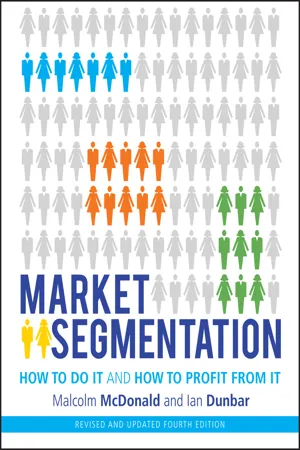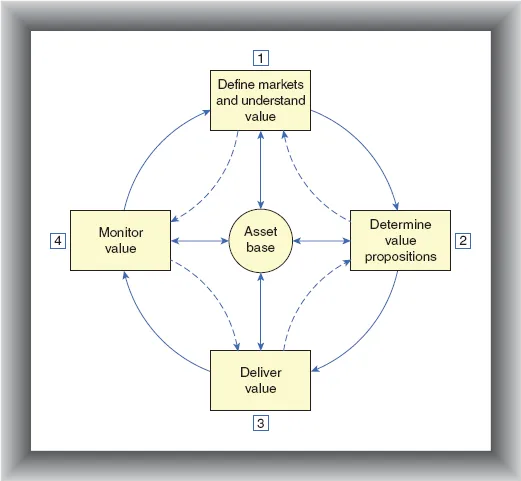![]()
Chapter 1
Market segmentation – the bedrock of successful marketing
Summary
This chapter contains a brief review of the state of marketing. It provides some key observations on why it has today lost much of its influence in the corporate world, in spite of all our best efforts. A model outlines what marketing should actually entail if it is to regain its rightful place at the heart of organizational strategy-making. At the core of this model of best practice is market segmentation.
It is the failure to get to grips with market segmentation that lies at the heart of much of marketing’s current malaise. This emphasizes the pivotal importance of this book, since little of what is best in marketing theory and practice works without correct market segmentation.
Before starting any project, let alone one as strategically critical as market segmentation, it is important to know where you are heading and what the route map looks like. A clear cut case is presented for the particular methodology to adopt, along with an overview of the process this methodology requires you to follow. Details of the process form the main content of this book.
This chapter is organized as follows:
- A review of marketing
- A definition of ‘marketing’ and what it actually entails
- The central role of defining markets and segments, and understanding value
- A review of different approaches to market segmentation and why the customer’s perspective defines the approach that delivers the best results
- A summary of the two phases and seven steps in the segmentation process
- The importance of setting marketing objectives for segments and implementing appropriate strategies
- A review of the chapter
Perception is everything
There are two principal determinants of whether or not market segmentation is acknowledged as the bedrock of successful marketing:
1. the perceived importance by senior management of marketing’s contribution to corporate strategy;
2. the perceived importance by marketing of market segmentation’s contribution to marketing strategy.
The first of these depends on the state of marketing in the organization, with the second dependent on marketing’s approach to segmentation.
The state of marketing
In numerous companies around the world, dedicated, professional marketers are making major contributions to the financial success of their companies. They achieve this through their detailed understanding of the markets they are in, in-depth insights into the needs of their customers1 and the development and delivery of carefully targeted value propositions. Yet, in spite of these shining stars, the future does not look good for the marketing discipline.
McDonald (2003) in a review of the record of marketing practitioners, consultants and academics over the preceding 20 years sadly concluded that marketing as an organizational function had been relegated from the position of a core strategy-making engine to a marginalized sales support department, in charge of T-shirts and promotion. To instigate a recovery in marketing and revitalize this key source of competitive power, McDonald went on to recommend that it was essential that the marketing function re-established its central role in strategy-making.
Kotler (2003) was also of the same opinion and described marketing as having declined from responsibility for the four ‘Ps’, product, price, promotion and place (distribution), to responsibility for only one ‘P’, promotion. As for how marketers could regain influence and status in their organizations, Kotler, like McDonald, also suggested that marketing needed to be a driver of business strategy.
By 2008 it appeared that the final nail had been hammered into marketing’s coffin following Deloitte’s highly critical report on how the discipline was viewed by senior management. Although the findings of Deloitte’s research2 were largely negative, marketing being seen as less influential, less strategic and less involved in the overall direction of the business than it had ever been, their report also contained some lifelines of hope. For example, the report suggested that chief executives were, in the main, supporters of marketing with, most notably, 85% agreeing, slightly or strongly, that marketing was crucial to the process of determining strategy. While this was certainly encouraging, the report also highlighted that, in reality, many chief executives had no real understanding of what marketing actually is.
From this, and many other papers on the state of marketing, it is not difficult to conclude that in the second decade of the twenty-first century, the discipline of marketing is destined to become increasingly less influential unless there is some kind of revolution, or at the very least a new beginning. Perhaps some paradigm shift will emerge, for little that is new has emerged from marketing for a good many years – and please do not say ‘relationship marketing’!
So what can be done to recover the marketing community from this sorry state?
First, we have to work hard to recapture the high ground – the strategy domain – and firmly establish it as a key, strategic function with a clearly defined purpose which can be measured, researched, developed, protected and examined. This, however, means reaching some kind of consensus about what marketing is.
The marketing community will have to work hard to recapture the high ground – the strategy domain – and firmly establish it as a key, strategic function.
Resolving the confusion about marketing
One of the stumbling blocks to those of us in marketing is the cacophony of definitions of marketing that exist. A selection of 20 such definitions is to be found in McDonald and Wilson (2011), most of which involve doing things to customers.
What many of these definitions lack is any form of guidance on what should be included and excluded, with the result that they are difficult to use in practice. Just like finance, human resources, or information technology (IT), marketing is a function, a specific business activity that fulfils a fundamental business purpose. Therefore, let us be unequivocal about marketing and in its definition describe marketing in terms of what it actually entails. Marketing is a process for:
- - - - - - - - - -
Definition:
Marketing is a process for:
- defining markets;
- quantifying the needs of the customer groups (segments) within these markets;
- determining the value propositions to meet these needs;
- communicating these value propositions to all those people in the organization responsible for delivering them, and getting their buy-in to their role;
- playing an appropriate part in delivering these value propositions (usually only communications);
- monitoring the value actually delivered.
For this process to be effective, organizations need to be consumer/customer driven.
- - - - - - - - - -
- defining markets;
- quantifying the needs of the customer groups (segments) within these markets;
- determining the value propositions to meet these needs;
- communicating these value propositions to all those people in the organization responsible for delivering them, and getting their buy-in to their role;
- playing an appropriate part in delivering these value propositions (usually only communications);
- monitoring the value actually delivered.
For this process to be effective, organizations need to be consumer/customer driven.
This process is shown diagrammatically in Figure 1.1.
Before expanding on each box, it will be clear that boxes 1 and 2 are about strategy determination, while boxes 3 and 4 are about tactical implementation and measurement. It is these latter two that have come to represent marketing as a function as this is where the sales support and promotional activities occur.
There is a new housing estate not far from one of the authors, where a large, eye-catching sign in the front garden of the show house proclaims the following: ‘The Marketing Suite’, loosely translated as: ‘This is where you come to get sold to’. And when government bodies, charities and the like say ‘we need marketing’, what they mostly mean is ‘we need some promotion’.
Looking in a little more detail at each of the boxes in Figure 1.1, it is the very first box, ‘Define markets and understand value’, that drives and determines all subsequent activities. It is here that markets are defined and where the needs of the customers in the segments comprising the market are understood as a precursor to moving onto the second stage of the process, ‘Determine value propositions’.
We have used the term ‘Determine value propositions’ to make plain that we are here referring to the decision-making process of deciding what the offering to the customer is to be – what value the customer will receive, and what value (typically the purchase price and ongoing revenues) the organization will receive in return. The process of delivering this value proposition, such as by making and delivering a physical product or by delivering a service, is covered by ‘Deliver value’.
It is well known that not all of the value proposition delivering processes will be under the control of the marketing department, whose role varies considerably between organizations. The marketing department should be responsible for and central to the first two processes, ‘Define markets and understand value’ and ‘Determine value propositions’, although even these need to involve numerous functions, albeit coordinated by specialist marketing personnel. The ‘Deliver value’ process is the role of the whole company, including, for example, product development, manufacturing, purchasing, sales promotion, direct mail, distribution, sales and customer service.
The marketing process is clearly cyclical, in that monitoring the value delivered will update the organization’s understanding of the value that is required by its customers. The cycle may be predominantly an annual one, with a marketing plan documenting the output from the ‘Define markets ...

